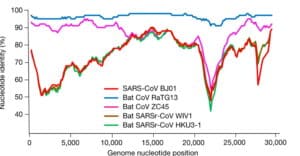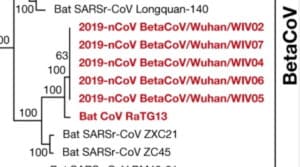Wouldn’t mutations, over time and likely quite long, devolve back to an original “type” without the gain of function developed thru gene editing?
Why when I try to decipher the OSF preprint I keep thinking we have a puzzle with more than 10,000 pieces, all which are constantly moving. I suspect the odds of putting in the last piece (vaccine) at just the right moment are infinitesimal. In the words of Island Girl “chimeric Frankenvirus” In search of an HIV vaccine, a monster more efficient in spread and killing has been created. Welcome to the brave new world. “In thinking themselves wise, they’ve shown their foolishness”
Danke sehr - good information. So it seems best if we do not count on an effective vaccine, or on lasting immunity. Dr. Chris’s latest video also discusses the observation that immunity seems to be short-lived, if the patient develops it at all. If we don’t expect lasting immunity, and/or the immunity does not extend to new/variable clades, then it seems that ‘herd immunity’ is also not to be expected in any given society.
I like the idea of ‘starving out’ the virus by everyone wearing masks when they are in populated areas. This may be the best solution, together with hygiene measures…
https://youtu.be/pyIkrnXijGk
She says Herd Immunity is not possible…but does not give much info in this interview.
Dr. Mayer, thanks for giving us several helpful analogies to try to follow what you are proposing.
I am intrigued by this and trying hard to follow. Please bear with me, I will share what I think you are saying, then you and others can correct me to clarify for the community. I am not a molecular biologist.
- Bat corona viruses and Pangolin coronavirus are from the Beta family of coronaviruses and both are in the lineage B of that family. So in some sense they share commonalities, perhaps different species within a genus, adapted to different hosts.
- SARS Cov-2 is most closely related to a specific Bat corona virus, nomenclature Bat Cov RaTG13 (originally called SL-CoV-Ra4991 and discovered circa 2013?). As you say “discovered”, did RaTG13 come from the wild? Who discovered it?
- Bat corona virus RaTG13 (blue line in chart below) is quite distinct from certain other Bat coronaviruses, the latter of which are in some way pertinent to SARS (green and brown lines). (Pink line is somewhat related to green and brown SARS Cov viruses in regions and somewhat related to RaTG13 in others). Apparently this uniqueness of RaTG13 is very significant. Is that in terms of discerning a direct evolutionary precursor or for some other reason? (I’m guessing here)
What I state above, I gather from the chart of “nucleotide identity at the same position” pasted below - a chart shared by Dr. Mayer in a link.

It also looks like there are two places in the nucleotide sequence where RaGT13 (blue line) is very different from all the other coronaviruses in this chart. One is somewhere between 20,0000 -25 ,0000 nucleotides and the other between 25,000 and 30,000 nucleotides. Is there some functional significance to the gene product or gene regulation in these ?
(You also say, tangentially, that the viruses represented by the colored lines are somehow controversial in the scientific community.) - RaTG13 is related somehow to other SARS WIV viruses named by researchers in the Wuhan lab, but is also distinct in some significant way, because it is on its own “branch”?

That whole cluster, if you will, is related to “controversial” SARS Cov ZC45 as well as SARS Cov ZXC21. The previous chart shows the areas of similarity between RATG13 (blue line) and ZC45 (pink line).
5. The next closest genetic relative to SARS Cov-2 is a corona virus derived from Pangolins. Generally speaking, Chinese bats bats from Yunnan caves do not live with Pangolins from Myanmmar. But Pangolins have been smuggled into China. You mention that three smuggled pangolins died of respiratory disease, from which I infer that pangolin coronavirus can be quite pathogenic to its natural host. - There is a Pangolin Cov 2020 virus that is also somehow related to Bat Cov ZC45 and Bat Cov ZXC21. I gather this from a section of a chart you linked to below. However, the pangolin Cov 2020 resides on its own “branch”.
Looking at the chart further, Bat Cov RAGT13 is somehow related to SARS Cov-2, and Pangolin Cov 2020 connects somehow to both of them.
I gather all this from the chart below that you linked to. I do not fully understand the relationship indicated by separate and connected branches on the tree.

Elsewhere in your post, it seems that this pangolin Cov is also called pCoV-MP789?. - If you take some of the features (I assume you mean nucleotide sequence?) of Bat Cov RATG13 and “cut and paste” some of the sequences of Pangolin Cov 2020, you get almost identical genetic sequence to SARS Cov2 that causes COVID-19 (99.6%).
(I assume cut and paste to preserve viral viability, but perhaps the pangolin features are so circumscribed that they could occur by mutation?)
Conclusion: In SARS Cov-2, the majority source RNA is Bat and the secondary source is pangolin. - Once you combine Bat SARS Cov RaGT13 and Pangolin Cov 2020 then add a cleavage site (the last 0.4% that is dissimilar perhaps?) you end up with SARS Cov-2.
Is this correct?
I have assumed that all along when you talk about similarities you are speaking of nucleotide sequences. The pertinent sequences I assume are either regulatory in nature or produce altered gene products that give us the functionality of SARS Cov -2.
Please correct any misunderstandings above, I would love to be able to follow what you are proposing.
Now in terms of functionality of SARS Cov-2:
You give us an analogy to cars and car keys and the virus is a carjacker. (By different types of cars, do you mean different types of human cells, or do you mean cells of different species of animal?). SARS Cov-2 can unlock the door and carjack many types of cars.
Now I have a new question: - Can you explain what functionality the (1) bat aspects, (2) the pangolin aspects, and finally (3) the cleavage site impart to SARS Cov-2?
I gather from back-and-forth posts that the spike protein of SARS Cov-2 is derived from RATG13, but that within that spike protein are mutations yielding 5 or 6 amino acid changes to the S protein binding site that make the binding site itself closer to pangolin Cov 2020.
Here’s some of the back-and-forth conversation:
The pangolin/1 has 5 out of 5 all-important RBD contact amino acids (AAs - red boxes) in common with the pangolin, and 8 out of 9 adjacent AAs (yellow boxes). It's closest 'bat relative' - RaTG13 only scores 1/5 for RBD contact, and 4/9 adjacent AAs. The other bat coronaviruses and SARS-classic are far worse.” ...The amino acid residues in question are L455, F486, Q493, S494,N501, and Y505. These six key positions within the Receptor Binding Domain portion of the Spike protein have been suggested to increase virulence as well as promote a firmer reception... ...More importantly, the Spike protein of RaTG13 scores 93.15% similarity to nCoV-2019 compared to only 84.52% from pCoV-MP789. The latter being the second higher scoring Spike comparison to this novel virus. Both the Spike protein (93.15/84.52) and the ORF1ab (96.52/90.36) are clear indicators that a Rhinopholus Affinis bat is the probable zoonotic origin of nCoV-2019 We should consider the potency of the the RaTG13 spike protein as more significant than pCoV-MP789 while simultaneously accepting the 6 amino acid residues within the RBD of pCoV-MP789 provide higher virulency. Does this make sense? Both have their merits and nCoV-2019 appears to be a blend of the two.Finally, 1. Why is Bat SARS Cov RAGT13 so significant? Where does it come from? 2. Is the main significance of pangolin RNA the spike protein mutation features of SARS Cov-2 or are there other aspects of pangolin RNA in SARS Cov-2? 3. Is the cleavage site unique? I gather it is unrelated to either the bat or the pangolin RNA sources or to any other pertinent beta corona virus in the B lineage? 4. Is the cleavage site you refer to the furin cleavage site somewhere in the S1/S2 subunits of the spike protein of that facilitate viral entry and make it more virulent? Or is the another cleavage site thatis pertinent? 5. Is this unique site cleaved by Cathepsin-L? 4. Finally is this unique cleavage site the SUPERMAN feature that you refer to below:
The KEY takeaway is that nCoV-2019 has a unique RNA insertion at a VERY crucial position that plays a vital role. That "type" of mutation is absent in ALL other betacovs (except one but lets ignore that lol).
nCoV-2019 has this 1 specific SUPERMAN feature that no other betacoronavirus possesses; including the aforementioned Bat and Pangolin viruses.Thanks Dr. Mayer.
Article from CNN describes research on T cell recognition of SARS-COv-2 in blood samples from people unexposed to this virus. Some people show cross-reactivity, various possible implications. I will also appended references from the primary literature.
Easy to read article:
https://www.cnn.com/2020/08/02/health/gupta-coronavirus-t-cell-cross-reactivity-immunity-wellness/index.html
Some of the related research on T cell targets in those exposed and unexposed:
https://www.cell.com/cell/pdf/S0092-8674(20)30610-3.pdf
A review of knowns and unknowns by the researchers:
https://www.nature.com/articles/s41577-020-0389-z